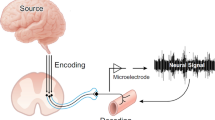Summary
Physical effort involves, along with an increase in the plasma concentration ofβ-endorphin, profound cardiovascular adaptations. The aim of the present study was to investigate with the use of the variable neck chamber technique, the influence of the endogenous opioids on the carotid baroreflex control of blood pressure and heart rate at rest as well as during exercise. Ten normal volunteers exercised in the supine position up to 33% and 66% of their maximal exercise capacity and received, in a randomized doubleblind cross-over protocol, either saline or naloxone (10 mg intravenously, followed by a continuous infusion of 10 mg·h−1). During exercise a progressive attenuation of the carotid baroreceptor reflex control of blood pressure and heart rate was noted. However, neither at rest nor during exercise, did opioid antagonism influence the carotid baroreceptor control of blood pressure and heart rate. Intra-arterial pressure and heart rate also remained unaffected. In contrast, both at rest and during exercise, naloxone administration produced a significant increase in the plasma concentration of cortisol. The latter suggests that in vivo the opioid receptors were effectively antagonized. In conclusion the present study confirms that opioids play only a minor role in cardiovascular homeostasis at rest. In addition, this study demonstrates that they are not involved in the cardiovascular adaptation to exercise, nor in the exercise-related attenuation of the carotid baroreceptor control of pressure and heart rate.
Similar content being viewed by others
References
Atweh SF, Kuhar MJ (1977) Autoradiographic localization of opiate receptors in rat brain. I. Spinal cord and lower medulla. Brain Res 124:53–67
Berkowitz BA, Ngai SH, Hempstead J, Spector S (1975) disposition of naloxone: use of a new radio-immunoassay. J Pharmacol Exp Ther 195:499–504
Carr DB, Bullen BA, Skrinar GS, Arnold MA, Rosenblatt M, Beitins IZ, Martin JB, McArthur JW (1981) Physical conditioning facilitates the exercise-induced secretion of betaendorphin and beta-lipotropin in women. New Engl J Med 10:560–563
Colt EWD, Wardlaw SL, Frantz AG (1981) The effect of running on plasma β-endorphin. Life Sci 28:1637–1640
Finley JCW, Lindstrom P, Petrusz P (1981) Immunocytochemical localization of β-endorphin-containing neurons in the rat brain. Neuroendocrinology 33:28–42
Fishman J, Roffwarg H, Hellman L (1973) Disposition of naloxone-7,8-3H in normal and narcotic-dependent men. J Pharmacol Exp Ther 187:575–580
Fraioli F, Moretti C, Paolucci D, Alicicco E, Crescenzi F, Fortunio G (1980) Physical exercise stimulates marked concomitant release of β-endorphin and adrenocorticotropic hormone (ACTH) in peripheral blood in man. Experientia 36:987–989
Freye E, Arndt JO (1979) Perfusion of the fourth cerebral ventricle with fentanyl induces naloxone-reversible bradycardia, hypotension and EEG synchronisation in conscious dogs. Naunyn Schmiedebergs Arch Pharmacol 307:123–128
Gambert SR, Garthwaite TL, Pontzer CH, Cook EE, Tristani FE, Duthie EH, Martinson DR, Hagen TC, McCarty DJ (1981) Running elevates plasma-endorphin immunoreactivity and ACTH in untrained human subjects. Proc Soc Exp Biol Med 168:1–4
Hökfelt T, Elde R, Johansson O, Terenius L, Stein L (1977) The distribution of enkephalin-immunoreactive cell bodies in the rat central nervous system. Neurosci Lett 5:25–31
Hughes J, Kosterlitz HW, Smith TW (1977) The distribution of metionine-enkephalin and leucine-enkephalin in the brain and peripheral tissues. Br J Pharmacol 61:639–647
Kaufman RD, Gabathuler ML, Bellville JW (1981) Potency, duration of action and pA2 in man of intravenous naloxone measured by reversal of morphine-depressed respiration. J Pharmacol Exp Ther 219:156–162
Koyama S, Manugian V, Ammons WS, Santiesteban HL, Manning JW (1983) Effect of naloxone on baroreflex, sympathetic tone and blood pressure in the cat. Eur J Pharmacol 90:367–376
Ludbrook J, Mancia G, Ferrari A, Zanchetti A (1977) The variable-pressure neck-chamber for studying the carotid baroreflex in man. Clin Sci Mol Med 53:165–171
Morley JE, Baranetsky NG, Wingert TD, Carlson HE, Hershman JM, Melmed S, Levin SR, Jamison KR, Weitzman R, Chang RJ, Varner AA (1980) Endocrine effects of naloxone-induced opiate receptor blockade. J Clin Endocrinol Metab 50:251–257
Naber D, Pickar D, Davis GC, Cohen RM, Jimerson DC, Elchisak MA, Defraites EG, Kalin NH, Risch SC, Buchsbaum MS (1981) Naloxone effects of β-endorphin, cortisol, prolactin, growth hormone, HVA and MHPG in plasma of normal volunteers. Psychopharmacology 74:125–128
Ngai SH, Berkowitz BA, Yang JC, Hempstead J, Spector S (1976) Pharmacokinetics of naloxone in rats and in man. Anesthesiology 44:398–401
Pegg PJ, Keane PM (1969) The simultaneous estimation of plasma cortisol and transcortin binding characteristics by a competitive protein binding technique. Steroids 14:705–715
Petty MA, Reid JL (1981) Opiate analogs, substance P, and baroreceptor reflexes in the rabbit. Hypertension 3 [Suppl 1]:I 142-I 147
Petty MA, Reid JL (1982) The effect of opiates on arterial baroreceptor reflex function in the rabbit. Naunyn Schmiedebergs Arch Pharmacol 319:206–211
Rubin PC, McLean K, Reid JL (1982) Endogenous opioids modulate central nervous system blood pressure control in man. Clin Sci 63:331s-333s
Staessen J, Fiocchi R, Bouillon R, Fagard R, Lijnen P, Moerman E, De Schaepdryver A, Amery A (1985) The nature of opioid involvement in the hemodynamic respiratory and humoral responses to exercise. Circulation 72:982–990
Staessen J, Fiocchi R, Fagard R, Hespel P, Amery A (1987) Progressive attenuation of the carotid baroreflex control of blood pressure and heart rate during exercise. Am Heart J 114:765–772
Staessen J, Fiocchi R, Bouillon R, Fagard R, Hespel P, Lijnen P, Moerman E, Amery A (1988) Effects of opioid antagonism on the haemodynamic and hormonal responses to exercise. Clin Sci 75:293–300
Watson SJ, Khachaturian H, Akil H, Coy DH, Goldstein A (1982) Comparison of the distribution of dynorphin systems and enkephalin systems in brain. Science 218:1134–1136
Author information
Authors and Affiliations
Rights and permissions
About this article
Cite this article
Staessen, J., Fiocchi, R., Fagard, R. et al. Carotid baroreflex sensitivity at rest and during exercise is not influenced by opioid receptor antagonism. Europ. J. Appl. Physiol. 59, 131–137 (1989). https://doi.org/10.1007/BF02396591
Accepted:
Issue Date:
DOI: https://doi.org/10.1007/BF02396591




